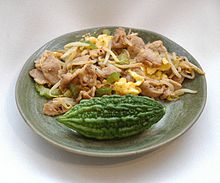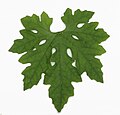Momordica charantia
| Momordica charantia | |
|---|---|

| |

| |
| Scientific classification | |
| Kingdom: | Plantae |
| Clade: | Tracheophytes |
| Clade: | Angiosperms |
| Clade: | Eudicots |
| Clade: | Rosids |
| Order: | Cucurbitales |
| Family: | Cucurbitaceae |
| Genus: | Momordica |
| Species: | M. charantia
|
| Binomial name | |
| Momordica charantia | |
Momordica charantia (commonly called bitter melon, goya, bitter apple, bitter gourd, bitter squash, balsam-pear, karavila and many more
Bitter melon originated in Africa,
Description
This section needs additional citations for verification. (March 2024) |
This
The fruit has a distinct warty exterior and an oblong shape. It is hollow in cross-section, with a relatively thin layer of flesh surrounding a central seed cavity filled with large, flat seeds and pith. The fruit is most often eaten green, or as it is beginning to turn yellow. At this stage, the fruit's flesh is crunchy and watery in texture, similar to cucumber, chayote, or green bell pepper, but bitter. The skin is tender and edible. Seeds and pith appear white in unripe fruits; they are not intensely bitter and can be removed before cooking.
Some sources claim the flesh (rind) becomes somewhat tougher and more bitter with age, but other sources claim that at least for the common Chinese variety the skin does not change and bitterness decreases with age. The Chinese variety is best harvested light green possibly with a slight yellow tinge or just before. The pith becomes sweet and intensely red; it can be eaten uncooked in this state, and is a popular ingredient in some Southeast Asian salads.
When the fruit is fully ripe, it turns orange and soft, and splits into segments which curl back to expose seeds covered in bright red pulp.
Varieties
Bitter melon comes in a variety of shapes and sizes. The cultivar common in China is 20–30 cm (7.9–11.8 in) long, oblong with bluntly tapering ends and pale green in colour, with a gently undulating, warty surface. The bitter melon more typical of India has a narrower shape with pointed ends, and a surface covered with jagged, triangular "teeth" and ridges. It is green to white in colour. Between these two extremes are any number of intermediate forms. Some bear miniature fruit of only 6–10 cm (2.4–3.9 in) in length, which may be served individually as stuffed vegetables. These miniature fruits are popular in Bangladesh, India, Pakistan, Nepal, and other countries in South Asia. The sub-continent variety is most popular in Bangladesh and India.
-
Two halved and two cross sections
-
Female flower
-
Ripe fruit
-
Leaf
Pests
M. charantia is one of the main
Uses
This section needs additional citations for verification. (March 2024) |
Cooking

| Nutritional value per 100 g (3.5 oz) | |
|---|---|
| Energy | 79 kJ (19 kcal) |
4.32 g | |
| Sugars | 1.95 g |
| Dietary fiber | 2 g |
0.18 g | |
0.84 g | |
Niacin (B3) | 2% 0.28 mg |
| Pantothenic acid (B5) | 4% 0.193 mg |
| Vitamin B6 | 2% 0.041 mg |
| Folate (B9) | 13% 51 μg |
| Vitamin C | 37% 33 mg |
| Vitamin E | 1% 0.14 mg |
| Vitamin K | 4% 4.8 μg |
| Minerals | Quantity %DV† |
| Calcium | 1% 9 mg |
| Iron | 2% 0.38 mg |
| Magnesium | 4% 16 mg |
| Manganese | 4% 0.086 mg |
| Phosphorus | 3% 36 mg |
| Potassium | 11% 319 mg |
| Sodium | 0% 6 mg |
| Zinc | 7% 0.77 mg |
| Other constituents | Quantity |
| Water | 93.95 g |
| †Percentages estimated using US recommendations for adults,[7] except for potassium, which is estimated based on expert recommendation from the National Academies.[8] | |
Bitter melon is generally consumed cooked in the green or early yellowing stage. The young shoots and leaves of the bitter melon may also be eaten as greens. The fruit is bitter raw and can be soaked in cold water and drained to remove some of those strong flavours.
China
In
India
Bitter gourd is commonly eaten throughout India. In North Indian cuisine, it is often served with yogurt on the side to offset the bitterness, used in curry such as sabzi, or stuffed with spices and then cooked in oil.
In

In northern India and Nepal, bitter melon, known as tite karela (तीते करेला) in Nepali, is prepared as a fresh pickle. For this, the vegetable is cut into cubes or slices, and sautéed with oil and a sprinkle of water. When it is softened and reduced, it is crushed in a mortar with a few cloves of garlic, salt, and a red or green pepper. It is also eaten sautéed to golden-brown, stuffed, or as a curry on its own or with potatoes.
Myanmar
In Burmese cuisine, bitter melon is sauteéd with garlic, tomatoes, spices, and dried shrimp and is served as an accompaniment to other dishes. Such a dish is available at street stalls and deli counters throughout the country.
Sri Lanka
It is called karavila (Sinhala: කරවිල) in Sri Lanka and it is an ingredient in many different curry dishes (e.g., karawila curry and karawila sambol) which are served mainly with rice in a main meal. Sometimes large grated coconut pieces are added, which is more common in rural areas. Karawila juice is also sometimes served there.
Japan

Bitter melon, known as gōyā (ゴーヤー) in Okinawan, and nigauri (苦瓜) in Japanese (although the Okinawan word gōyā is also used), is a significant ingredient in Okinawan cuisine, and is increasingly used in Japanese cuisine beyond that island.
Pakistan
In Pakistan, where it is known as karela (کریلا) in
Indonesia
In Indonesian cuisine, bitter melon, known as pare in Javanese and Indonesian (also paria), is prepared in various dishes, such as gado-gado, and also stir-fried, cooked in coconut milk, or steamed. In Christian areas in Eastern Indonesia it is cooked with pork and chilli, the sweetness of the pork balancing against the bitterness of the vegetable.
Vietnam
In Vietnamese cuisine, raw bitter melon slices known as mướp đắng or khổ qua in Vietnamese, eaten with dried meat floss and bitter melon soup with shrimp, are common dishes. Bitter melons stuffed with ground pork are commonly served as a summer soup in the south. It is also used as the main ingredient of stewed bitter melon. This dish is usually cooked for the Tết holiday, where its "bitter" name is taken as a reminder of the bitter living conditions experienced in the past.
Thailand
In Thai cuisine, the Chinese variety of green bitter melon, mara (มะระ) in Thai, is prepared stuffed with minced pork and garlic, in a clear broth. It is also served sliced, stir-fried with garlic and fish sauce until just tender. Varieties found in Thailand range from large fruit to small fruit. The smallest fruit variety (mara khii nok) is generally not cultivated, but is occasionally found in the wild and is considered the most nutritious variety.

Philippines
In the
The name of the fruit is rooted in the bitterness of its taste, (Filipino: Ampait) which means bitter. In pre-colonial Spanish in
Trinidad and Tobago
In
Africa
In Mauritius, bitter melons are known as margose or margoze.
Herbal medicine
Bitter melon has been used in various Asian and African herbal medicine systems.[11][12] In the traditional medicine of India, different parts of the plant are used.[13]
Research
There is little evidence that Momordica charantia has uses against cancer, diabetes, fever, HIV and AIDS, or infections.[14] While it has shown some potential clinical activity in laboratory experiments, "further studies are required to recommend its use".[14] For fever reduction and relief of menstrual problems, there is no scientific research to back these claims.[14]

Momordica charantia does not significantly decrease fasting blood glucose levels or A1c, indicators of blood glucose control, when taken in capsule or tablet form.[15] The Memorial Sloan Kettering Cancer Center concludes that bitter melon "cannot be recommended as a replacement therapy for insulin or hypoglycemic drugs".[14]
Adverse effects
A possible side effect is gastrointestinal discomfort.[14]
Pregnancy
Bitter melon is
Bitter melon tea
| Bitter melon tea | |
|---|---|
 | |
| Type | Herbal tea |
| Other names | Bitter melon, balsam pear, Momordica chinensis |
| Origin | Brazil |
| Quick description | Traditional medicinal. Makes a green, earthy broth also used in soup. |
Bitter melon tea, also known as gohyah (goya) tea, is an herbal tea made from an infusion of dried slices of the bitter melon. It is sold as a medicinal tea, and a culinary vegetable.
Gohyah is not listed in the
Subspecies
The plant has one subspecies and four varieties:
- Momordica charantia var. abbreviata
- Momordica charantia var. charantia
- Momordica charantia ssp. macroloba
- Momordica charantia L. var. muricata
- Momordica charantia var. pavel
M. charantia var. charantia and pavel are the long-fruited varieties, whereas M. charantia var. muricata, macroloba and abbreviata feature smaller fruits.[16]
Gallery
Plant
-
Seeds
-
Seeds
-
Unusualconjoinedtwin fruit
Dishes and other uses
-
Ready to be cooked
-
Malaysian-style, cooked with sambal, onion, and red bird's-eye chili peppers
-
Gōyā chanpurū
-
Salad
-
Sabzi (mixed vegetables and spices) from India
See also
- Momordica balsamina (balsam apple)
- Momordica cochinchinensis(gac)
- Momordica cymbalaria
- Momordica foetida
References
- ^ BSBI List 2007 (xls). Botanical Society of Britain and Ireland. Archived from the original (xls) on 2015-06-26. Retrieved 2014-10-17.
- ^ PMID 32994347.
- ^ Bitter Melons. Watertown, Massachusetts: Peabody Museum, Documentary Educational Resources. 1966. Retrieved 19 April 2021.
- ^ Bagchi, Indrani (11 April 2005). "Food for thought: Green 'karela' for Red China". The Times of India. Archived from the original on 24 May 2013.
- UIC Heritage Garden
- )
- ^ United States Food and Drug Administration (2024). "Daily Value on the Nutrition and Supplement Facts Labels". Retrieved 2024-03-28.
- )
- PMID 25203006.
- ISBN 9789400717640.
- PMID 15182917.
- PMID 15588650.
- PMC 4027280.
- ^ Memorial Sloan-Kettering Cancer Center. Retrieved 17 October 2013.
- PMID 22895968.
- ^ Cytogenetics of two Indian varieties of Momordica charantia L. (bittergourd) by Ipshita Ghosha, Biplab Kumar Bhowmickab, Sumita Jha. Center of Advanced study, Department of Botany, University of Calcutta. 11 June 2018. Retrieved 8 January 2022.
















